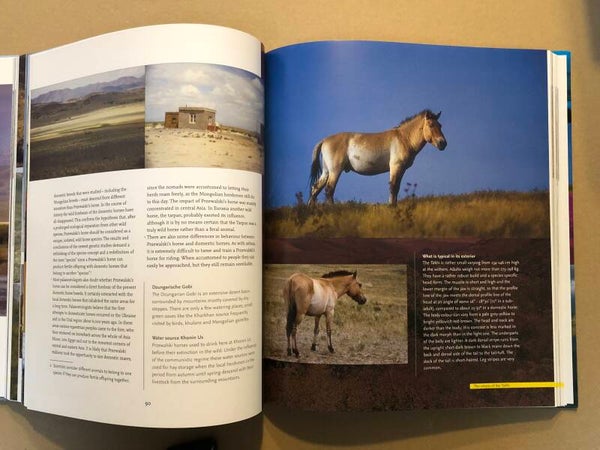Het Przewalski Paard - Terug in Mongolië - ENGELS - NIEUW
Hardcover in absolute nieuwstaat, zonder inschrijvingen.
INCLUSIEF BIJBEHORENDE DVD, NOOIT AFGESPEELD
The Tale Of The Przewalski's Horse - Bringing Back The Last Wild Horses To The Heartland Of Genghis Khan
Auteur: Piet Wit Inge BouwmanCo-auteur: Ina Bouman
- Engels
- Hardcover
- 9789050112369
- 01 januari 2006
- 208 pagina's
Tienduizenden jaren waren wilde paarden de overheersende diersoort op de steppen van Azië en Europa, bij uitstek aangepast aan dit type terrein. Met zijn lenigheid en uithoudingsvermogen was het paard de uitgelezen compagnon voor de mens bij het veroveren van de wereld. Tegelijk met het van minder betekenis worden van ruiterij bij de oorlogvoering verdwenen ook de laatste wilde paarden uit de natuur. Omstreeks 1900 snelden een aantal rijke verzamelaars naar een uithoek van de Gobi-woestijn om een paar exemplaren te vangen uit de laatst overgebleven groepjes van dit trotse paard, dat wetenschappers de naam 'Przewalski paard' gaven, naar een Pools onderzoeker die hen had ontdekt. Slechts twaalf van deze gevangen wilde paarden leven voort in hun huidig nageslacht.
Toen Inge Bouman, auteur van dit boek, in 1970 op huwelijksreis in Praag, het Przewalski paard achter de troosteloze tralies in de dierentuin zag besloten zij en haar man hun leven te wijden aan het terugbrengen van dit prachtige dier naar het wild. Dit boek vertelt over hoe zij hun doel bereikten. Het markeert een doorbraak in de manier waarop wij aankijken tegen herintroductieprogramma's van bedreigde diersoorten. Het Przewalski paard ofwel 'Takh', zoals de Mongoliers het noemen, heeft een positieve rol gespeeld voor de bescherming van ecosysteem van Hustai Nationaal Park en haar omgeving. Het effende het pad voor de ontwikkeling van een geïntegreerd begrazingsbeheer en verbetering van het bestaan van de locale herders.
Dit boek is bedoeld als bron van inspiratie voor een ieder, waar ook ter wereld, die een herintroductieprogramma wil starten. Waar begin je, hoe betrek je de locale bevolking erin, hoe los je financiële consequenties op. Maar het boek is ook het verhaal van een fascinerend Mongolië, haar geschiedenis, haar natuur en cultuur, haar nomadische bevolking met zijn eeuwenoude tradities, die de Takhi met zoveel warmte weer in hun armen gesloten heeft.
For tens of thousands of years wild horses roamed over the grasslands of Europe and Asia. Their endur-ance and agility made them the perfect partner for man during his conquest of the world. The loss of im-portance of the domesticated horses for the cavalries of the world coincided with the disappearance of the last horses from the wild. Around 1900 some wealthy collectors rushed to the edge of the Gobi desert to catch a few specimen from the last marginalised groups of the proud horse that scientists baptised the 'Przewalski's horse', after the Polish explorer who has discovered them. Only twelve of these captured wild horses live on in their present offspring.
In the 1970s the Dutch couple Jan and Inge Bouman, on their honeymoon, visited the zoo in Prague. Seeing the wild horse petering away behind bars and fences, they decided to dedicate their life to the ideal of bringing the Przewalski's horse back to the wild. This book tells a success story. It marks a break-through in the way we look at reintroduction projects of endangered species. The Przewalski's horse or 'Takh', as the Mongolians call it, has played a catalytic role for the protection of the mountain steppe eco-system of Hustai National Park and its surroundings. It paved the way for the development of integrated pasture management and livelihood improvement of the local herdsmen.
This book aims to be an inspiration for anyone trying to start a reintroduction project, anywhere in the world. Where do you start, how to cope with the local people, how to solve financial issues. Apart from that, it is a personal view on the extraordinary country that is called 'Mongolia' and it's wonderful people.























